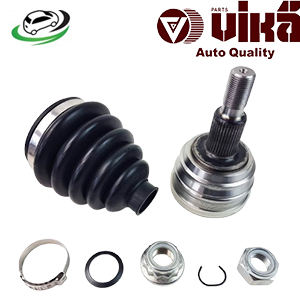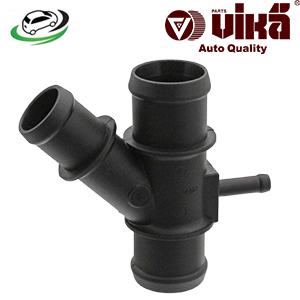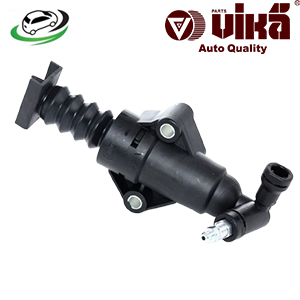-8%
Get Clutch Slave Cylinder AUDI A3/TT / VW Bora/Golf 1J0721261F
The clutch slave cylinder is a crucial component in the clutch system of a manual transmission vehicle. It plays a key role in the operation of the clutch by facilitating the disengagement and engagement of the clutch disc from the flywheel. Understanding its design, function, common issues, and maintenance is essential for ensuring smooth operation and prolonging the life of your vehicle’s clutch system.
Design and Function
Design:
- Construction:
- Cylindrical Housing: The clutch slave cylinder is typically a cylindrical component made of cast iron, aluminum, or other durable materials. This housing encloses the internal components and is designed to withstand high hydraulic pressures.
- Piston: Inside the cylinder, there is a piston that moves back and forth in response to hydraulic pressure. The piston is usually made of metal or a composite material and is sealed with rubber O-rings to prevent leakage.
- Seal and Boot: The cylinder is equipped with a seal or boot to prevent dirt, moisture, and other contaminants from entering the cylinder. This helps maintain the integrity of the hydraulic fluid and ensures proper operation of the piston.
- Connection:
- Hydraulic Line: The clutch slave cylinder is connected to the master cylinder via a hydraulic line. This line transmits hydraulic fluid (usually brake fluid) from the master cylinder to the slave cylinder.
- Pushrod: The piston in the slave cylinder is connected to a pushrod, which in turn is linked to the clutch release fork. When the piston moves, it actuates the pushrod and the release fork, which disengages or engages the clutch.
Functionality:
- Hydraulic Actuation:
- Fluid Transmission: When the clutch pedal is pressed, hydraulic fluid is pushed from the master cylinder through the hydraulic line to the slave cylinder. This hydraulic pressure moves the piston within the slave cylinder.
- Clutch Engagement/Disengagement: The movement of the piston in the slave cylinder pushes the pushrod, which then actuates the clutch release fork. This action disengages the clutch disc from the flywheel, allowing the driver to change gears smoothly.
- Precision and Control:
- Smooth Operation: The hydraulic system ensures a smooth and consistent application of force to the clutch release fork. This precision allows for more accurate clutch control compared to mechanical systems.
- Reduced Pedal Effort: The hydraulic system also reduces the effort required to operate the clutch pedal. The hydraulic fluid amplifies the force applied by the driver, making clutch operation easier and more comfortable.
Types of Clutch Slave Cylinders
- Conventional Slave Cylinder:
- Design: The conventional slave cylinder is a basic hydraulic cylinder with a piston that moves in and out based on hydraulic pressure. It operates in a traditional clutch system with a separate master cylinder.
- Application: This type is commonly used in older vehicles or in systems where the master and slave cylinders are connected by a hydraulic line.
- Integrated Slave Cylinder:
- Design: The integrated slave cylinder is designed as a single unit with the release bearing. This design eliminates the need for a separate release bearing and reduces the number of components in the system.
- Application: Integrated slave cylinders are often found in modern vehicles and are used to simplify the design of the clutch system and reduce maintenance requirements.
- Remote Slave Cylinder:
- Design: The remote slave cylinder is mounted away from the clutch assembly, often in a different location on the transmission. It is connected to the clutch release fork via a linkage.
- Application: This design is used in certain applications where space constraints or other design considerations require the slave cylinder to be located away from the clutch assembly.
Common Issues with Clutch Slave Cylinders
- Fluid Leaks:
- Seal Failure: One of the most common issues with the clutch slave cylinder is leakage of hydraulic fluid. This can occur due to seal failure or damage to the cylinder. Leaks can lead to a loss of hydraulic pressure, causing the clutch to fail to disengage properly.
- Visual Signs: A visual inspection may reveal signs of leaking fluid around the slave cylinder or on the ground beneath the vehicle. Low fluid levels in the master cylinder reservoir may also indicate a leak in the system.
- Air in the Hydraulic System:
- Spongy Pedal: Air trapped in the hydraulic lines can cause a spongy or soft clutch pedal. This is because air compresses more than hydraulic fluid, reducing the effectiveness of the clutch system.
- Bleeding Required: To resolve this issue, the hydraulic system may need to be bled to remove the trapped air. This involves opening the bleed valve on the slave cylinder and pumping the clutch pedal until all air bubbles are removed from the system.
- Piston Seizure:
- Lack of Movement: The piston within the slave cylinder can seize or become stuck due to corrosion or lack of lubrication. This can prevent the piston from moving properly, resulting in difficulty disengaging the clutch.
- Inspection and Replacement: Regular inspection of the slave cylinder and the use of proper brake fluid can help prevent piston seizure. If the piston is seized, the slave cylinder may need to be replaced.
- Clutch Engagement Issues:
- Difficulty Shifting Gears: If the slave cylinder is not functioning correctly, it can cause difficulty in shifting gears. This may be due to insufficient movement of the clutch release fork or improper hydraulic pressure.
- Adjustment and Repair: In some cases, the issue may be resolved by adjusting the clutch system or bleeding the hydraulic lines. However, if the problem persists, the slave cylinder may need to be inspected or replaced.
Maintenance and Replacement
- Regular Inspection:
- Visual Checks: Regularly inspect the clutch slave cylinder for signs of leaks, damage, or contamination. Check the hydraulic fluid level in the master cylinder reservoir and look for any signs of fluid loss.
- Pedal Feel: Pay attention to the feel of the clutch pedal. If you notice any changes in pedal effort, sponginess, or difficulty in engaging or disengaging the clutch, it may indicate a problem with the slave cylinder.
- Fluid Maintenance:
- Brake Fluid: The clutch slave cylinder typically uses brake fluid (DOT3, DOT4, or DOT5.1) as the hydraulic fluid. Ensure that the fluid level is maintained within the recommended range and that the fluid is replaced at regular intervals according to the manufacturer’s recommendations.
- Fluid Quality: Use only the recommended type of brake fluid to avoid potential damage to the hydraulic system. Contaminated or old brake fluid can cause issues with the clutch system and affect the performance of the slave cylinder.
- Replacement:
- Timely Replacement: If the clutch slave cylinder is found to be faulty or leaking, it should be replaced promptly to avoid further damage to the clutch system. A faulty slave cylinder can lead to difficulty in shifting gears and potential damage to the clutch components.
- Professional Assistance: Replacing the clutch slave cylinder typically involves removing the transmission or accessing the clutch assembly. This is a complex task that may require professional assistance, especially for vehicles with integrated or remote slave cylinders.
- System Bleeding:
- Proper Bleeding: After replacing or repairing the clutch slave cylinder, it is important to bleed the hydraulic system to remove any air trapped in the lines. This ensures that the system operates correctly and provides proper clutch engagement and disengagement.
- Bleeding Procedure: Follow the manufacturer’s recommended bleeding procedure, which usually involves opening the bleed valve on the slave cylinder while someone pumps the clutch pedal. Ensure that all air bubbles are removed and that the hydraulic fluid is topped up as needed.
Follow us on Facebook for more parts.



